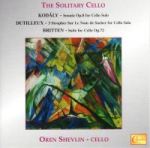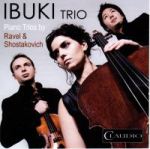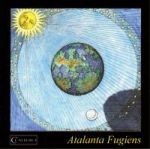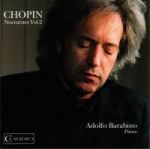
Triggered
by a very fine recording of Shostakovich's Piano Trio in E minor I travelled
to Peacehaven in Sussex in March 2013 to talk to the engineer/owner
of Claudio Records. On the cliffs above the town is his family home
and company headquarters. Here we talked for nearly two hours about
engineering stereo recordings. It was a rare opportunity to hear from
the horse's mouth some of the technical issues of which we, as listeners,
are ignorant. Colin has several decades experience within the industry,
detailed on his website, making his comments doubly interesting.
Since the work of the recording engineer begins with his microphones,
I started by asking Colin about his approach to microphone placement.
He says he tries to find the 'ultimate spot'. The microphones (pro-AKG
or pro-Neumann pairs rebuilt by himself to optimise sound) get the best
seats, he said. He uses his ears to find the best place in the auditorium,
but his ears are trained by 29 years of owning the same microphone pairs
in the case of the Neumann’s, so he hears as his microphones hear.
(This is technical, but in a nutshell a microphone responds to sounds
differently to a human ear). Since he is not restricted by an auditorium
seat this ultimate spot may be, indeed usually is, some height above
any usual sitting position. When searching for this perfect place he
will often have to resort to a stepladder. Height is beneficial because
the clearest wave fronts from individual instruments, especially strings,
are usually at an upward angle. He records pianos with their lids off
particularly because that way he can treat them like a harp and place
microphones where all strings are equally visible and fairly equidistant.
This also makes for an even frequency response from the keyboard, a
balance of bass and treble. In a sense he has to use his eyes as well
as his ears to set up because the instrument's visibility is a good
guide to its optimum audibility.
For reasons we will come to later, he uses only a single pair of microphones
and this makes the positioning more difficult if all instruments are
to be placed for the best sound. Because of this he will, in the recording
sessions, move instrumentalists into places that suit his microphones
and his ears rather than the other way round, at the same time optimizing
the instruments for their ‘sweet spots’. For example, the
piano trio in that Shostakovich recording was placed with the violin
adjacent to, and to the left of the piano as seen from the keyboard,
and the cello to the right. Both were facing away from the pianist at
about a 45 degree angle (requiring the use of a mirror so that the pianist
could be seen by the strings). The stand holding the microphone pair
was placed at the foot of the piano with each microphone having one
lobe of its figure-of-eight response towards each string player. The
two microphones were thus at 90 degrees to each other and spaced 120mm
apart, see below for an explanation of this distance. The rear response
lobe of the microphones are aimed away from the musicians picking up
the ambience of the recording space, here a church. Because the violinist
and cellist would then be 'aiming' their sound boards beneath the microphone
he had both players on tables to raise their aiming point to the height
of the microphone. If one considers the trio's position relative to
the microphone this required the channels to be reversed at the recorder
to get the violin to sound from the left and the cello from the right.
It sounds artificial as described and probably had its comic aspects
for the musicians but the resultant stereo sound is quite remarkably
pure and 'natural', an improvement on the audience's listening position,
rather than something radically different. Recording live concerts,
said Colin, is always a compromise because he can only place microphones
at the best available position and cannot move musicians from standard
concert layout, no tables when in front of an audience! Because of all
this, the musicians have to trust the engineer to get it right. Colin
trusts the musicians to perform at their best for his recordings and
he in return expects them to trust him to capture their best sound and
the best balance.
This trust is partially earned by trying not to stress his musicians
overmuch, i.e. wasting time 'playing' with his setup. They want to play
music, not watch an engineer climbing ladders and moving them around.
To this end he keeps detailed notes of sessions for future reference.
The notes are written and diagrammed pages showing exact equipment used,
positioning and height of microphones, placing of musicians, including
which way they are facing, and technical details of recording formats,
type of microphone used and so on.
All of this requires careful preparation not only before each session
but in the sense of being optimally equipped for any and all projects.
Colin puts maximum energy into getting every recording as good as possible.
To that end he spends around £2000 on each pair of microphones.
He has two main pairs he has owned for well over a decade and relies
on all the time. He has measured the distance between his own eardrums
(120mm - presumably by calculation not major surgery!) and emulates
this by setting his microphones at that distance on pre-drilled metal
bars that are then mounted on the stands. Despite having bought expensive
microphones from the likes of AKG or Neumann he still opens them up
and removes filters, switches and anything else that degrades the quality
of sound. He places his own-design microphone pre-amps (CMA-1XE
http://www.claudiorecords.com/equipment.html)
close to the microphones so that only amplified signals are sent down
long cables to the recording devices. He never uses mixers.
He is scheduled to record two of the UK's major orchestras. In both
cases they will be subjected to the same manipulation of position as
the piano trio mentioned above. So the orchestra for a piano concerto
will be placed almost in a circle around the piano and on tiered seating.
This will allow line of sight from every musician to his single pair
of microphones. He stresses that you cannot put a microphone in a convenient
place and let the players get on and play. The process of recording
for optimum 'natural' sound is of necessity artificial. Musicians, he
believes, do not enjoy having multiple microphones close to them anyway,
so his use of just two at a sensible distance goes down well with players.
This is in marked contrast to the standard multi-microphone recordings
of the big companies.
As an example of the traditional approach he describes the philosophy
of one major player during the heyday of recording two or three decades
ago. This classical recording company believed 'if it is in the score
then you must hear it'. First they tried to get an acceptable sound
in the recording venue using probably a main crossed pair plus up to
30 or 40 close microphones spread around the orchestra. They carried
out a rough mix in the control room recording all microphone feeds at
an optimal level for minimum distortion. In post production back at
the studio the resultant tracks were then tweaked by ear to a level
that allowed every note in the score to be heard but without losing
a proper balance. This was an essentially musical aim but required a
lot of microphones, good ears and good replay equipment at the mixing
desk. The big problem with this whole approach is still that multiple
microphones receive multiple wave fronts arriving at different moments
and this makes for 'phase distortion', an artifact that the human ear
can detect with ease and which damages the sense of reality.
In passing he notes that phase distortion is one of two reasons why
he does not use surround recording: the extra microphones will add to
phase problems. The other reason is that with the latest high quality
stereo ‘matched’ microphones surround is not necessary in
achieving a pure, natural almost three dimensional image! If the final
mix is being made in the studio this means judgments are limited by
the quality of replay equipment, most especially the monitor speakers.
Colin uses a pair of vintage (1967) BBC LS5 1A monitors and Quad ESL
63s. He knows of one engineer who uses more recent Quad ESLs for this
stage with wonderful results. For Colin it is important to know the
monitors just as he knows the microphones, but regardless of this they
have to be at an acceptable standard. He does question the replay standards
adopted by critics - with good reason! If someone is going to publicly
pronounce on the sound quality of an issue (and possibly affect sales)
they should be able to point to their replay chain as being up to the
required level. Some might do better, he thinks, to use good headphones
where the quality can be achieved at lower cost.
He has nailed his colours to the mast for 24 bit word-length at a sampling
rate of 192 kHz as the absolute standard and artists like the results.
He is eager to do more big orchestra recordings to prove his point still
more using a technique used in the days of Sir Thomas Beecham but with
his special Q-LAB system, his name for the processes (or lack of processes!)
he uses to keep the recording chain as pure and simple as possible.
Tests carried out at the Wigmore Hall some time ago demonstrated to
his satisfaction that, compared to a direct feed (from microphones to
microphone-amps to power-amps to speakers), all recording machines inserted
into the chain introduced audible losses until the machine worked at
24/192. Even the now-standard 24bit/96kHz, says Colin, is not quite
good enough. CDs produced from 24/192 masters are better than those
produced from lower resolution masters, despite having been downsampled
for the CD format. The big problem is that because of lack of take-up
there is little software capable of post-producing 24/192 sources onto
DVD-A - which is also then limited to 66 minutes storage in stereo.
Blu-ray, which can store large amounts of 24/192, is very expensive
to produce and thus a problem for the budget. Despite all this he is
convinced 24/192 is 'right' and he records everything at that rate.
There is a growing American market for these DVD-As. He rejects SACD
in passing because it can't store 24/192 and the SACD standard insists
on imposing DSD coding which he says does not sound so good. It is also
impossible to get the results manufactured in UK because no SACD processing
plant exists within these shores. He believes that this insistence on
24/192 will eventually pay dividends and that HD is the future for real
music lovers. He bemoans the fact that we now have the best processing
available (24/192) but despite that the new 'standard' is 24/96 and
not usually in simple stereo!
Colin agrees in a sense with the suggestion that recording techniques
have not improved much since the 1960s and 70s. The technology of microphones
and microphone amplifiers has of course improved but the way in which
they are used has not. The use of larger numbers of microphones has
made it easier to get the sound the engineer wants in the mixing room
afterwards. For this reason he characterized it as a bit of a compromise
system but with the benefits of post production correction for bad balances.
The modern approach is always to use many microphones. He cites an example
of an Eastern European recording project where the people he was working
with on an orchestral recording actually preferred the sound he was
getting with a single stereo pair but felt under pressure to use their
standard multi-microphone approach because it was more modern and showed
they had progressed. He feels that in a way he is going back to the
early days of electrical recording when the musicians were crowded around
the single microphone to make sure that microphone had the best possible
sound from every instrument. The primary difference now is that with
modern microphones a single pair will suffice to capture an entire chorus
and orchestra within their natural acoustic if placed optimally.
He would have been happy to talk for much longer but my time had run
out. I have to publicly thank him for his time and his frankness about
his work. He sees himself as one of a fairly small group of professional
enthusiasts for realistic recording. In an age of data-reduced MP3 downloads
and multi-mike recording it is a brave and maybe uneconomic attitude.
There are other paradigms followed by other engineers, but his seems
well justified by his results. As evidence here are a handful of Colin's
recordings, reviewed very briefly to give a flavour of his work as engineer.

Zoltan
KODALY (1882-1967)
Sonata Op.8 for Cello Solo [30.19]
Henri DUTILLEUX (b.1916)
3 Strophes Sur Le Nom de Sacher for Cello Solo [9.34]
Benjamin BRITTEN (1911-1976)
Cello Suite No.1 Op.72 [20.37]
Oren Shevlin (cello)
rec. St Bartholomews Church, Brighton, England 2000
Claudio Records CD CC5046-2 [64.07]
This is a gem of a CD recorded in Colin's favoured acoustic, that of
St Bartholomew's Church in Brighton. The programme is interesting of
itself and the cellist is masterly. Oren Shevlin has been principal
cello of the WDR Symphony Orchestra, Cologne for about 15 years and
has a notable career as soloist with orchestras around Europe. He has
not made life easy for himself by recording these three works, the Kodaly
and Britten being amongst the peaks of 20th century cello repertoire.
It is worth buying for the Kodaly alone, which is performed with a level
of skill and insight that takes the breath away. The recording is quite
beautiful and makes one wonder why anyone bothers with surround sound
when plain stereo CD can sound this spacious without losing the tight
focus of the cello at the centre of the stereo stage.

Maurice
RAVEL (1875-1937)
Piano Trio
Dmitri SHOSTAKOVICH (1906-1975)
Piano Trio No.2 in E minor Op.67
Ibuki Trio, Ben Wragg (violin), Laura Anstee (cello), Kan Tomita (piano)
rec. St Bartholomews Church, Brighton, England 2008
Claudio Records DVD-Audio CR5890-6 High-Definition 24 bit 192 kHz Stereo,
also available on CD CR5890-2
This was the recording that drew my attention to Colin's engineering
skills. It is an object lesson in stereo sound recording of a small
chamber group and described at length above. Fortunately the performances
of both trios are excellent and worth owning for musical reasons as
well. It could be argued that other recorded performances present the
Shostakovich in a more powerful light but none, I am sure, sound so
good as this. A CD is available but I only reviewed the high-definition
DVD-A. For those who can play such discs, owners of universal players
or Blu-ray players, it is a valuable addition to your music collection.

Michael
MAIER (1569-1622)
The Fifty Fugues of Atalanta Fugiens [71.58]
Rachel Platt and Emily van Evera (sopranos), Rufus Müller (tenor),
Richard Wistreich (bass and director)
rec. St Margarets Church Putney January 1986
Claudio Records DVD-Audio CR5468-6 High-Definition 24 bit 192 kHz Stereo
(2 discs), also available on CD CR5468-2 (1 disc). The DVD-A data takes
more space than can be stored on one DVD, the CD is complete on one
disc. The original recording was on analogue tape.
I can only refer interested readers to the Wikipedia article on Michael
Maier where he is described as " a German physician and counsellor to
Rudolf II of Habsburg, a learned alchemist, epigramist and amateur composer."
Atalanta Fugiens is described there as "an alchemical emblem
book ... published in 1617; alongside images, poems, and discussion,
it included fifty pieces of music in the form of fugues." Listening
to this remarkable recording for any length of time induces a sort of
hypnotic fascination. On the DVD-A one seems to be sharing the church
with these three singers in a private performance. It is spectacularly
realistic and musically intriguing. It also demonstrates how long Colin
has been making these fine recordings since it dates back to pre-digital
days when he recorded using analogue open-reel tape.

Frédéric
CHOPIN (1810-1849)
Nocturnes Op.37, Op.48, Op.55, Op.62, Op.post.72, C sharp-minor Op.post.
Adolfo Barabino (piano)
rec. St Bartholomews Church, Brighton, England 2005
Claudio Records CD CR5570-2 [57.50]
Barabino is up against very serious competition with this CD because
Chopin's Nocturnes are standard repertoire for all the great pianists.
He certainly conjures up a dreamy world, with drama where required,
and his recording is again very fine. This CD is Volume 2 of the Nocturnes,
volume 1 also being available from Claudio Records on CR5569-2.
